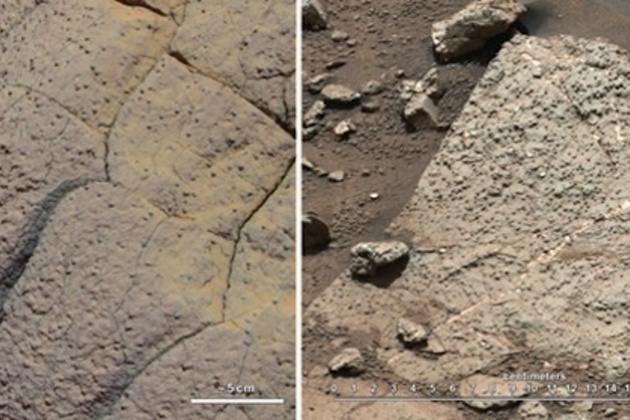Two Mars rocks, L to R: Wompay rock in Endurance Crater as seen by Opportunity, and Sheepbud unit in Gale Crater as seen by Curiosity via
After about seven months roving the Martian surface, Curiosity has hit pay dirt--er, a pay rock. The rover drilled into a rock at a site called John Klein and found evidence of a past environment suitable for life.
People are freaking out, of course--putting “Mars” and “life” in the same sentence usually has that effect. And the media isn’t exactly helping set the record straight. On Wednesday, USA Today published the headline “Mars Has Life’s Bare Necessities.” That’s not totally true. Evidence of a past life-supporting environment doesn’t mean the planet can support life now, and it's worth keeping in mind that scientists have suspected this environment for a while.
First, the life. When NASA says Curiosity found a rock with evidence for a past environment that would have been suitable for life, that life isn’t complex organisms. It's microorganisms. Things like bacteria and microscopic plants.
This ultra-simple life supporting ex-environment was found in a rock containing evidence of clay minerals, something that is typically produced when other minerals interact with water. And it looks like the water at John Klein was pleasant, neutral or slightly alkaline instead of the acidic and salty areas the rovers Spirit and Opportunity encountered. This mineralogical composition combined with the geologic evidence in Gale Crater--Curiosity’s general landing site--suggests that the rover is sitting on an ancient Martian lakebed. Lakes have been predicted on Mars but this is the first hard evidence that one actually existed on the surface. But it’s the oxidized and reduced elements found in the rock that are really exciting. These are chemical gradients Earth-like microorganisms could have possibly exploited as an energy source.
It’s exciting news. But it doesn’t mean Curiosity’s mission can be declared a success and operations shut down. Far from it. The rover was designed "to explore and quantitatively assess a local region on Mars' surface as a potential habitat for life, past or present." With such vague wording the mission is poised for success whatever the rover finds, but it also means there’s plenty for Curiosity to do during its operational life time.
It’s actually not entirely surprising that Curiosity has made such an important discovery a little over a quarter into its two year primary mission. NASA didn’t launch the $2 billion rover at Mars and hope. Knowledge on Mars is cumulative. Gale Crater was specifically selected as Curiosity’s landing site because previous missions found it was an interesting place worth studying. And John Klein has long been a site within Gale Crater to which NASA hoped to steer this rover.

NASA's Mars Odyssey orbiter, which hosts the THEMIS instrument (via)
Two orbital missions in particular shaped Curiosity’s mission: the European Space Agency’s Mars Express and NASA's Mars Reconnaissance Orbiter (MRO). Both orbiters carry imaging spectrometers, instruments that qualify an area’s chemical composition by measuring the absorption spectrum of light reflecting off the surface. In the case of Mars Express, the instrument is called OMEGA; on MRO it’s called CRISM. Both are capable of creating high resolution maps of Mars’ varying surface composition, and both operate in the shorter wave near-infrared wavelengths. This allows these instruments to “see” water bound into crystals and other minerals like sulfates and carbonates. These spectrometers were the instruments that found clay minerals from orbit, making Gale Crater an appealing landing site for Curiosity.
That Curiosity found clay minerals at John Klein was a bit lucky since neither OMEGA nor CRISM saw significant clay deposits from orbit. But NASA’s Mars Odyssey orbiter did. Odyssey is armed with THEMIS, the Thermal Emission Imaging System that combines a 5-wavelength visual imaging system with a 9-wavelength infrared imaging system. THEMIS found John Klein to be rich in clay minerals. Just why one spectrometer saw what two others failed to see is a question for the Curiosity team to answer.
Up next for Curiosity–and more importantly, for the science team behind the rover–will be further study of John Klein. At least one more sample will be drilled to paint a more complete picture of the variety and composition of the site. It will also give the scientists a better understanding of the site’s history, specifically how long the microorganism-supporting environment lasted and roughly when in the planet’s history. There’s also a lot of interest in how the material found at John Klein relates to the rest of Gale Crater. Curiosity’s work is far from done.
